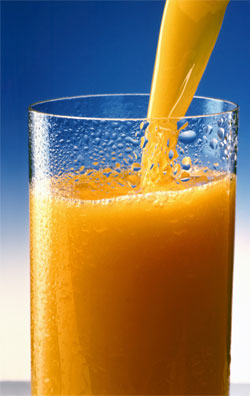
The squeezing, macerating or crushing of fruits is done in the process of extracting juice from fruits. A considerable amount of pulp is obtained by this process or it may be extracted using water. These juices are used either in their natural concentrations or may be concentrated by evaporation or freezing and they are preserved by canning, freezing or drying. Deterioration of fruits results from physical factors, its own enzyme action, microbial action or combination of all these.
Juices extracted from fruits are acidic in nature. For the lemon juice, the pH is 2.4 and for tomato juice is 4.2. They also contain high sugar content of about 2% in lemon juice and about 17% in some grape juices. Mold growth is favored on the surface of these juices. Bacteria and yeast grow faster when juices are exposed to high moisture. Removal of solids by extraction and sieving of juices makes the oxidation-reduction potential to become higher which in turn favors the growth of yeast. Lack of vitamin B discourages some bacteria.
The normal change expected in raw fruit juice is the alcoholic fermentation by yeasts at room temperature. If acetic acid bacteria are present, the alcohol produced may be converted to acetic acid. Depending on the type of fruit juice and temperature, the type of yeast growing on them also varies. The wild yeasts produces moderate amount of alcohol and volatile acids carry out the first fermentation. At temperatures ranging from 15.6-350C undesirable yeast grow and produces undesirable flavors. At temperatures above 32-350C, lactobacilli grows producing lactic acid and also some volatile acids. The acidity may be reduced by film yeasts and molds growing on the surface.
In addition to alcoholic fermentation, fruit juices also undergo other changes caused by microorganisms;
1. Lactic acid fermentation of sugars, by hetero fermentative lactic acid bacteria such as Lactobacillus pastorianus, L. brevis and Leuconostoc mesenteroides in apple or pear juice, and by homo fermentative Lactobacillus arabinosus, Lactobacillus leishmanii and Microbacterium.
2. The fermentation of organic acids of the juice by lactic acid bacteria, example; Lactobacillus pastorianus, malic acid to lactic and succinic acids, quinic acid and citric acid to lactic acid and acetic acids.
3. Slime production by Leuconostoc mesenteroides, Lactobacillus brevis and Lactobacillus plantarum and streptococci in grape juices.
Concentrates of fruit juices because of their increased acidity and sugar concentration, favor the growth of yeasts and of acid- and sugar- tolerant Leuconostoc and Lactobacillus species. Such concentrates are usually canned and then heat-treated or frozen. Heat processing kills the important microorganisms that could cause spoilage, and freezing prevents the growth of such organisms.
The character of spoilage depends on the product attacked and the microbe that causes the spoilage. When the food is soft and juicy, the fruit rot is appropriate to be soft and squashy and some leakage may result. Whereas, certain organisms cause a drying effect, which results in dry, leathery rots with the discolored surface area. In case of apples, rotting appears only as a spot. The identification of the type of spoilage will help in finding out the appropriate method for preventing its decay.





